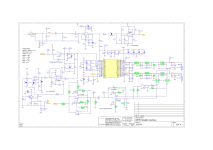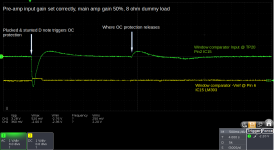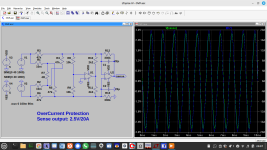This is a 600W bass guitar amplifier, I have seen 3 of these for repair in the last few years, the same complaint is that during gigs the amp will cut out for about 4 seconds once or twice during a 3 hour period ... I couldn't replicate the fault here with the first 2 so put it down to other circumstances e.g. faulty connecting leads or overheating.
The third one though that appeared with the same 4 second cutout complaint could be replicated here and was traced to the overcurrent detection circuit, strangely at first it would only trigger on playing D notes hard and would play fine anywhere else on the guitar (this has now progressed to triggering the OCP on ANY loud note) but was definitely only D notes when it first arrived, I've never seen anything like it before.
The fault is definitely isolated to the output of the amp module, up to the input of the amp module (pin 4 IC 4) all pre-amp signal levels are as they should be. As an ex pro player I have plenty of experience correctly setting up pre-amp input gain etc. and have actually used this model of amp myself in the past... ***Components marked "FO" are not present on the PCB:

I have removed the 40pin Class D amp module (no easy task) and checked the 4x 2SK3592 mosfets and gate drive wave forms etc. which all seem fine, while it was off I re-flowed all solder joints ... I've attached the amp module PDF below.
So with the pre-amp set up correctly for normal nominal signal level and the amp gain at 50% any note played hard on the bass trips the window comparator IC15 (LM393) for 4 seconds, I've checked all the obvious suspects e.g. voltage rail sag but there is none, or the current sense resistors R51, 52, 75, 76 being out of spec. and they are also fine (measured out of circuit with a kelvin wired LCR meter).
Maybe it's just the way the OCP circuit is drawn on the schematic but I find it confusing looking at all the parallel connections, I think that IC9B's output will swing to either rail voltage, then 9A is a differential amplifier into the LM393 comparator (the voltages on the schematic are what has been measured, the components marked in green have been checked & the IC's 15 & 9 have been replaced).
The owner has an alternative amp to use so this has been here for months now with me coming back to it whenever I've got some spare time, just to make sure there was no PCB damage or broken component legs etc. I've removed all components from the amp outputs to the speaker outputs from the board and checked them and all PCB tracks finding nothing. Here's the scope traces for comparator input vs -Vref for visualisation:

There's nothing left for me to test & I haven't found anything obviously wrong but this is an unusual power amplifier with a hybrid linear and regulated switch mode power supply, quite frankly I'm stumped and could do with some advice from the more experienced or any suggestions for some sort of solution, it's very frustrating, if you play gently/normally everything is fine but pluck a note hard and the amp is shutdown for 4 seconds.... 🙁
The third one though that appeared with the same 4 second cutout complaint could be replicated here and was traced to the overcurrent detection circuit, strangely at first it would only trigger on playing D notes hard and would play fine anywhere else on the guitar (this has now progressed to triggering the OCP on ANY loud note) but was definitely only D notes when it first arrived, I've never seen anything like it before.
The fault is definitely isolated to the output of the amp module, up to the input of the amp module (pin 4 IC 4) all pre-amp signal levels are as they should be. As an ex pro player I have plenty of experience correctly setting up pre-amp input gain etc. and have actually used this model of amp myself in the past... ***Components marked "FO" are not present on the PCB:

I have removed the 40pin Class D amp module (no easy task) and checked the 4x 2SK3592 mosfets and gate drive wave forms etc. which all seem fine, while it was off I re-flowed all solder joints ... I've attached the amp module PDF below.
So with the pre-amp set up correctly for normal nominal signal level and the amp gain at 50% any note played hard on the bass trips the window comparator IC15 (LM393) for 4 seconds, I've checked all the obvious suspects e.g. voltage rail sag but there is none, or the current sense resistors R51, 52, 75, 76 being out of spec. and they are also fine (measured out of circuit with a kelvin wired LCR meter).
Maybe it's just the way the OCP circuit is drawn on the schematic but I find it confusing looking at all the parallel connections, I think that IC9B's output will swing to either rail voltage, then 9A is a differential amplifier into the LM393 comparator (the voltages on the schematic are what has been measured, the components marked in green have been checked & the IC's 15 & 9 have been replaced).
The owner has an alternative amp to use so this has been here for months now with me coming back to it whenever I've got some spare time, just to make sure there was no PCB damage or broken component legs etc. I've removed all components from the amp outputs to the speaker outputs from the board and checked them and all PCB tracks finding nothing. Here's the scope traces for comparator input vs -Vref for visualisation:

There's nothing left for me to test & I haven't found anything obviously wrong but this is an unusual power amplifier with a hybrid linear and regulated switch mode power supply, quite frankly I'm stumped and could do with some advice from the more experienced or any suggestions for some sort of solution, it's very frustrating, if you play gently/normally everything is fine but pluck a note hard and the amp is shutdown for 4 seconds.... 🙁
Attachments
Last edited:
I was maybe a bit vague as to what help I was looking for, I put this in the power supply forum hoping that someone who designs over current protection circuits would see the schematic, understand exactly how the OCP works from the output of this Class D module & confirm it to me so I can try to find what is causing this common problem on these amps.
I can't find any obvious faults but being unsure of how this OCP works I might be missing something really simple .... or if there is further testing I can carry out that will help then a few pointers would be well appreciated... 🙂
I can't find any obvious faults but being unsure of how this OCP works I might be missing something really simple .... or if there is further testing I can carry out that will help then a few pointers would be well appreciated... 🙂
Looking at the schematics the OCP wiring of op-amps does not make any sense to me.
On the other hand, if OCP trips on special notes I suspect your speaker cabinet shows some impedance drop.
You may check with a dummy load whether the problem persists.
Fixing you amp with the obvious faulty schematics will be quite difficult.
On the other hand, if OCP trips on special notes I suspect your speaker cabinet shows some impedance drop.
You may check with a dummy load whether the problem persists.
Fixing you amp with the obvious faulty schematics will be quite difficult.
Maybe I am too dumb to understand that tricky circuitry.
Anyway I would try to check out the 10mR shunt resistors for their correct resistance,
these are the most suspicious parts here imho.
Anyway I would try to check out the 10mR shunt resistors for their correct resistance,
these are the most suspicious parts here imho.
Had another look at the schematics and begin to understand - but no indication visible for tripping at a specific frequency with a dummy load.
OP only stated problem first showed on a specific note.
Now it is any note.
No indication of what load the module is playing into that I can see.
Now it is any note.
Where does the OP state he is testing with dummy load?I see you did test with a dummy load - so no idea what goes on
No indication of what load the module is playing into that I can see.
Thanks for the replies... the load was detailed at the top of the scope trace image. I've tested with both 8 & 4 Ohm dummy loads as the original guitar combo cabinet was designed with a single 8 Ohm woofer with optional on/off tweeter or 4 Ohm load with added extension cabinet.Where does the OP state he is testing with dummy load?
No indication of what load the module is playing into that I can see.
As detailed above the first elements suspected were the 5V rails supplying the comparator Vref thresholds and the value of the current sense resistors...
So it happens with any hard struck note - ok.
Connect a scope to you bass guitar output and you will find that hard striking the strings produces harsh unsymmetrical transients, maybe these trigger the OCP. Obviously this is a HiFi-amp, not suitable for uncompressed live music.
Connect a scope to you bass guitar output and you will find that hard striking the strings produces harsh unsymmetrical transients, maybe these trigger the OCP. Obviously this is a HiFi-amp, not suitable for uncompressed live music.
Please read the 1st sentence of my original post... this is NOT a hifi amp...Obviously this is a HiFi-amp, not suitable for uncompressed live music.
As far as I can see, it's working as designed. The spike is exceeding the -2V threshold. Double check the gain of the previous stage to make sure the high value resistors haven't drifted upwards in value. If the op-amp supplies are solid during the note, then I'd up the window comparator threshold to +/- 3V and see how that goes with real world signals.
Yes it is working as designed but I haven't found the reason it's now tripping and I've checked everything so I'm obviously missing something. I havent monitored the op amp supplies ... will try that soon. And yes upping the thresholds (or as was suggested by the pre-amp designer disabling the OCP) would work but I 'd like to have found out why it's tripping & want to keep the OCP.As far as I can see, it's working as designed. The spike is exceeding the -2V threshold. Double check the gain of the previous stage to make sure the high value resistors haven't drifted upwards in value. If the op-amp supplies are solid during the note, then I'd up the window comparator threshold to +/- 3V and see how that goes with real world signals.
This is what is used at the output of the pre-amp to limit transients... there is no problem with the signal before it gets to the amp module in the schematic.Guitar amplifiers often have diodes across the input to suppress transients.
I don't know about Bass amplifiers but could this work?
This is an unusual overcurrent problem ... not a normal instrument amplifier problem ... I think this is the best place, where the most experienced OCP designers will be.This should be moved to instruments & amps thread.
Moderator please.
Wasn't thinking there in previous reply ... the comparator supply was the first thing I suspected and checked ... it's been months since I last had a look at it though so I'm gonna set it up for testing again.If the op-amp supplies are solid during the note
Voltage rails are all solid ... I think later I'll try changing the centre resistor in the 5 resistor voltage divider R85 to 12k or maybe 10k ... that should bring the thresholds up to about +/-3V ... 🙂
Last edited:
In the meantime can one of you guys explain to me what is happening in this part of the circuit with IC9B pin 7 giving an output of either +/-VDD rail voltage (5V) to the inputs of IC9A? ... I find the parallel connection confusing?

- Home
- Amplifiers
- Power Supplies
- Class D repair, overcurrent tripping problem?
